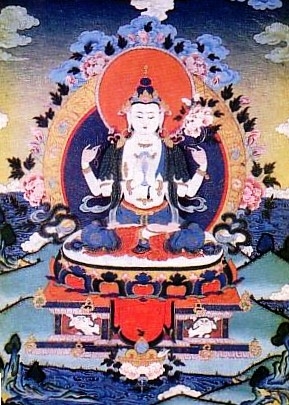Mani mantra: Difference between revisions
Jump to navigation
Jump to search
No edit summary |
|||
| Line 14: | Line 14: | ||
==Further Reading== | ==Further Reading== | ||
*[[Sogyal Rinpoche]], ''[[The Tibetan Book of Living and Dying]]'', Appendix Four, pages 396-398. | *[[Sogyal Rinpoche]], ''[[The Tibetan Book of Living and Dying]]'', Appendix Four, pages 396-398. | ||
*[[Dilgo Khyentse Rinpoche]], Patrul Rinpoche, ''The Heart Treasure of the Enlightened Ones'' (Boston: Shambhala, 1993) | |||
==Notes== | ==Notes== | ||
Revision as of 08:15, 16 November 2023

The Mani mantra is the six syllable mantra of Avalokiteshvara: oṃ mani padme hūṃ (Skt.; Tib. ཨོཾ་མ་ཎི་པདྨེ་ཧཱུྂ༔, om mani pémé hung, Wyl. oM ma Ni pad+me hU~M`:). In the terma tradition, Avalokiteshvara's seed syllable hrīḥ is added to the end of the mantra, making seven syllables.
Benefits of the Mani Mantra
It is said:
- Reciting oṃ mani padme hūṃ one hundred or one thousand times is of equal merit to reciting the whole of the Kangyur.
- Reciting oṃ mani padme hūṃ ten thousand times closes the door to rebirth in the lower realms.
- Reciting oṃ mani padme hūṃ one million times one will reach the level of an irreversible bodhisattva.
- Reciting oṃ mani padme hūṃ ten million times one will attain perfect buddhahood.
Padmasambhava said:[1]
- Om Mani Padme Hung is the quintessence of the Great Compassionate One, so the merit of uttering it just once is incalculable. It is possible to count the number of raindrops falling during twelve years of monsoon, but the merit of uttering the Six Syllables just once cannot be counted. It is possible to count the drops of water in the great ocean, one by one, but the merit of uttering the Six Syllables just once cannot be counted.
Further Reading
- Sogyal Rinpoche, The Tibetan Book of Living and Dying, Appendix Four, pages 396-398.
- Dilgo Khyentse Rinpoche, Patrul Rinpoche, The Heart Treasure of the Enlightened Ones (Boston: Shambhala, 1993)
Notes
- ↑ In Jewels of Enlightenment - Wisdom teachings from the great Tibetan masters, compiled and translated by Erik Pema Kunsang; edited by Marcia Binder Schmidt & Michael Tweed (Boston: Shambhala, 2003)